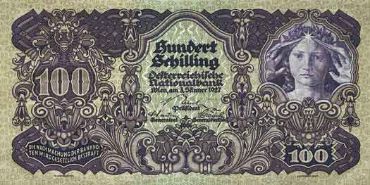1922–1938
1816 – 1818 | 1818 – 1878 | 1878 – 1922 | 1922 – 1938 | 1938 – 1945 | 1945 – 1998 | from 1999 |
The Oesterreichische Nationalbank during the First Republic
A new beginning

Since the start of the liquidation of the Austro-Hungarian bank, it was clear that Austria, like the remaining successor states, had to have a bank of issue of its own. But first of all, it was necessary to establish order in the national budget. The Geneva Protocol of October 1922 provided a basic framework for an orderly budget.
The statutes of the new Austrian central bank were passed as a federal law on November 14, 1922. The statutes provided for the business name “Oesterreichische Nationalbank” (OeNB), thus reinstating the venerable name of the institution that had been accorded the sole right to issue banknotes in line with a modern concept of monetary policy as early as 1816. The fundamentals of the statutes were in line with the guidelines set up by the League of Nations for full central bank independence from credit demands of the state, autonomous governance, and an adequate provision of capital to underpin this independence.
On January 1, 1923, the “reestablished” Oesterreichische Nationalbank started operation.
This new beginning was also expressed by a move into new headquarters in Vienna. Even before 1914, the management of the Austro-Hungarian Bank had commissioned the construction of a new building in the ninth district of Vienna, but only the shell of the building designed to accommodate the printing works had been completed by the time the OeNB was reestablished. The OeNB management decided to have the new building completed to house all departments including the printing works. The inauguration ceremony for the new bank building was finally held on March 22, 1925.
The first great test for the new central bank was to implement the recommendations of the Financial Committee of the Council of the League of Nations to stabilize the Austrian currency. To this end, the Schilling Conversion Act (Schillingsrechnungsgesetz) was passed on December 20, 1924. This law provided for the introduction of the schilling currency on January 1, 1925. The schilling replaced the Austrian crown, which had been legal tender since 1892; the conversion rate was 10,000 Austrian crowns to the schilling.
Crisis management

The mastermind behind the consolidation of public finances in the First Republic was Viktor Kienböck, who was Minister of Finance from 1922 to 1924 and from 1926 to 1929, President of the Oesterreichische Nationalbank from 1932 to 1938 and OeNB Vice President from 1952 to 1956. Under his management, the Austrian schilling weathered the Great Depression unscathed and remained a stable currency up to 1938.
This stable framework allowed the OeNB to concentrate on crisis management during the series of bank failures Austria faced. The crisis of the bank Credit-Anstalt in 1931 marked the climax and finale of this series.
The tragic events of the civil war waged in Austria in 1934 had little effect on the business practices of the OeNB. In fact, confidence in the so-called “Alpendollar” (Alpine dollar) was so great, even internationally, that the government and the central bank were able to repay the 1923 League of Nations bond in 1934. But the favorable monetary situation was marred by the great number of unemployed persons in Austria, a circumstance that had severe consequences for domestic policy.
